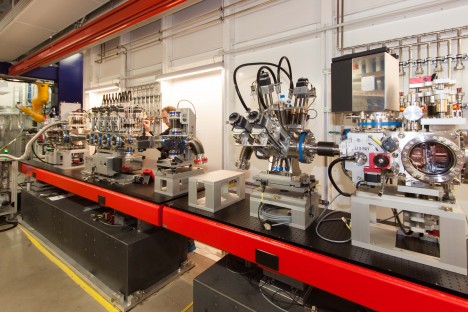For the first time, scientists from around the world can now submit their proposals for experiments at the European XFEL. The international science facility in the Hamburg metropolitan region published the first call for applications for “beamtime” on its website. The user programme is expected to begin in the second half of the year, with two of the planned six instruments being initially available. An international panel of experts will review the proposals on the basis of scientific excellence.

The FXE instrument, which is currently being assembled in its hutch in the European XFEL experiment hall, will enable studies of ultrafast processes such as decisive intermediate steps of chemical reactions. Credit: European XFEL
After successful review of their proposals, research groups are granted access to use the European XFEL—that is, the extremely brilliant X-ray light flashes at one of the facility’s instruments—for a few days for their research projects. Use of the facility is free of charge provided the results are made generally available through publication. Like other X-ray light sources, the European XFEL is a research facility that provides capabilities and scientific knowhow for external researchers. The start of user operation will mark one of the final big milestones in the commissioning of the 3.4 km long X-ray laser.
Creating molecular movies
The first two instruments in the experiment hall for which proposals can be submitted are the Femtosecond X-Ray Experiments (FXE) instrument and the Single Particles, Clusters, and Biomolecules and Serial Femtosecond Crystallography (SPB/SFX) instrument. FXE enables investigations of ultrafast processes and the creation of “molecular movies”, which show the progression of an individual reaction with high precision. This will give impulses to many areas of research, including studies of mechanisms of various diseases at the molecular level, energy research, or the optimization of chemical processes.
Research into biomolecules
The other instrument, SPB/SFX, is specialized for research into biomolecules and other biological materials. Understanding the atomic-level details of biomolecules can enable the development of new medications and therapies. With the European XFEL, scientists will be able to determine structures from tiny crystals of biomolecules. These crystals will be easier to create than the larger crystals needed for X-ray light sources up to now, which can take years or even decades to produce. In addition, it is expected that X-ray lasers in the medium term will also pave the way for structural determination of individual, uncrystallised molecules.
Currently, the European XFEL is in the process of being put into operation. The next steps that follow are the further commissioning of accelerator sections, the generation of X-ray laser light (first lasing), and the commissioning of the instruments. After the first experiment campaign starting in the fall, the equipment at the instruments and the options for experiments will be increased or further improved until the full capabilities of the European XFEL are reached. The current programme for the first experiments is planned for a two-month period. The next announcement of experiment time is expected in summer 2017 for experiments in the first half of 2018. From 2018 on, four further instruments will be available, each of which is dedicated to specific applications and research themes. Text: XFEL
For more information please view http://www.xfel.eu/call_for_proposals/.

